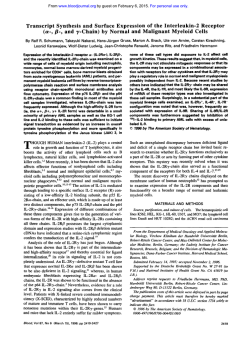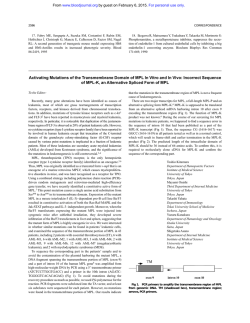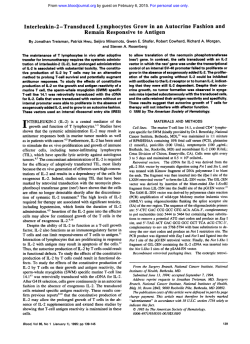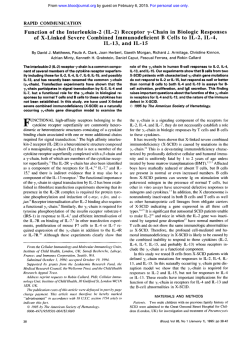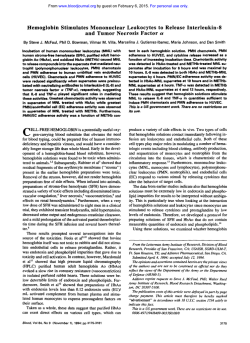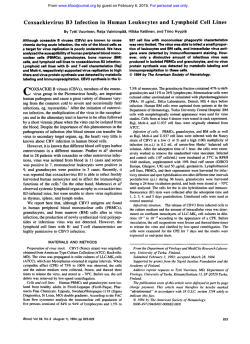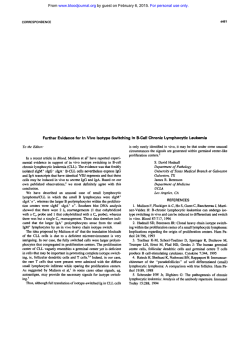
Expression of Interleukin-2 Receptor y Chain on Human
From www.bloodjournal.org by guest on February 6, 2015. For personal use only. Expression of Interleukin-2 Receptor y Chain on Human Neutrophils By Jin Hong Liu, Sheng Wei, DeWayne Ussery, P.K. Epling-Burnette, Warren J. Leonard, and Julie Y. Djeu The interleukin-2 (IL-2) receptory is an indispensable functional componentof IL-2, IL-4, and IL-7 receptors, and thus, is denoted the common y chain, ye. The present study was undertaken to determine whether human polymorphonuclear neutrophils (PMNs) expressed yc chain. Reverse transcription-polymerase chain reaction and Northern blot analysis showedthat fresh humanPMN constitutively expressed a remarkable level of ye mRNA,whichisof the sizeand intensity ofthat from the peripheral blood mononuclear cells (PBMCs). Granulocyte macrophage-colony stimulating factor, IL-2, and IL-8, which are known to activate PMN functions, failed to regulatethe ye gene expression. Westernblot analysis with a rabbit anti-ye polyclonal antibody identified 64-, 58-, and 50-kD yc bands in lysates from PMN, but only 64- and58-kDbandsfromPBMCs.After the PMNsand PBMCs were treated with tunicamycin to prevent N-linked glycosylation, Westernblot analysis detected asingle 39-kD band, which is equal to the calculated molecular weight from the cloned cDNA. Thus, our results indicatethat PMNs constitutively express high levels ofye and the three forms detected arecausedbydifferentglycosylationof aprotein translated from asingle mRNA species. 0 1994 by The American Society of Hematology. I tissue damage in certain inflammatory diseases such as rheumatoid arthritis." PMNs function and recruitment to the site of inflammation have been shown to be upregulated by various cytokines, including IL-1, 1L-8, tumor necrosis factor (TNF), interferon y (IFNy), and granulocyte macrophagecolony stimulating factor (GM-CSF).".'"PMNs have also been shown to be the major cells responsible for tumor regression in mice after cytokine gene therapy with G-CSF or IL-2 gene-transfected cell^.'^.'^ Histology of the regressing tumors indicated that rejection of the L-2-transfected tumor cells was associated with PMN infiltration, the intensity of which is directly proportional to the amount of IL-2 re1ea~ed.I~ In one clinical trial, local injection of low-dose IL2 into the tumor mass and near the draining lymph nodes of patients with advanced primaryheadand neck squamous carcinomas resulted in the infiltration of granulocytes into the tumor tissue, which may have partially contributed to tumor rejection." We have shown that PMNs can respond to IL-2 with increased antifungal activity, prolonged survival in vitro, and increased IL-8 and TNFa-induced gene expression.3.7.19.20Circulating human PMNs express intermediateaffinity receptors for IL-2 as measured by Scratchard analysis and express IL-2Rp, but not IL-2Ra.' The discovery of the intermediate-affinity receptor on PMNs and knowledge that heterodimerization of IL-2RP and y c is required for signaling2' suggested to us that y c may likely be expressed on PMNs. Therefore, we wished to explore the possibility that yc is also present in PMNs, which may contribute to the intermediate L - 2 binding affinity. Our results show that PMNs constitutively express high levels of yc mRNA and protein, and that the cytokines known to activate PMN function did not alter y c gene expression. NTERLEUKIN-2 (IL-2) plays a central role in the clonal expansion of activated T-cells with specific surface receptors.'.2 The IL-2/IL-2 receptor (IL-2R) system has been widely studied in lymphocytes,2but it is becoming apparent that IL-2 can mediate multiple biologic functions innonlymphoid cells, including activation of monocytes and granulocyte~.'-~ These observations suggest that IL-2 is a principal regulator among immune cells and IL-2 delivers various signals to a wide range of cell types via interaction with its cell surface receptor. The IL-2R is unique among growth factor receptors in that it is made up of at least three distinct membrane components: IL-2Ra, IL-2RP, and y e , which is a newly identified peptide chain unrelated to anyknown molecule including the FcRy. Different combinations of these three distinct chains dictate the affinity of the IL-2R. Whereas low-affinity receptors contain IL-2Ra chain, intermediate-affinity IL-2R contain IL-2RP and ye chains. Highaffinity receptors contain all three chains.Is2y c is encoded by the gene that is defective in X-linked severe combined immunodeficiency' and has also been shown to be a functional component of IL-4 and IL-7 receptors?-'2 Polymorphonuclear neutrophils (PMNs) are one of the principal cellular components of host defense and are major effector cells against pathogenic microbes and in inflammatory response. The generation of a variety ofmRNA and proteins relevant to their effector functions and the release of granule enzymes by these phagocytes constitute an important part of their armory designed to defeat invading microbes. Activated PMNs are also involved in the pathogenesis of From the Immunology Program, H. Lee Mofltt Cancer Center, and the Departments of Medical Microbiology and Biochemistry, University of South Florida College of Medicine, Tampa, FL; and the National Heart, Lung and Blood Institute, Section on Pulmonay and Molecular Immunology, Bethesda, MD. Submitted May 2, 1994; accepted August 2, 1994. Supported by Public Health Service Grant No. CA-46820. Address reprint requests to Jin Hong Liu, MD, Immunology Program, H. b e Mofitt Cancer Center, University of South Florida College of Medicine, 12902 Magnolia Dr, Tampa, FL 33612. The publication costs of this article were defrayedin part by page chargepayment. This article must therefore behereby marked "advertisement" in accordance with 18 U.S.C. section 1734 solely to indicate this fact. 0 1994 by The American Society of Hematology. 0006-4971/94/8411-0029$3.00/0 3870 MATERIALS AND METHODS Preparation of PMNs and PBMCs. Leukocyte buffy coats obtained from healthy normal volunteers, at South West Florida Blood Bank (Tampa, FL) were diluted 1:2 in PBS and centrifuged over FicolUHypaque (Pharmacia Fine Chemicals, Piscataway, NJ) at 4% for 30 minutes at room temperature. The human peripheral blood mononuclear cells (PBMCs) layer was collected and washed twice and used in experiments. The PMN layer lying on the surface of the erythrocyte cell pellet was collected and lysed free of contaminating erythrocytes by hypotonic shock with sterile distilled water for 30 seconds at room temperature. The cells were washed twice in PBS before adjusting to the desired cell concentration. Careful washing of the PMN preparations, such as centrifugation at 20Og. aspiration Blood, Vol 84, No 11 (December I ) , 1994: pp 3870-3875 From www.bloodjournal.org by guest on February 6, 2015. For personal use only. 3871 y. EXPRESSION ON HUMAN NEUTROPHILS of supernatants followed by gentle resuspension with a pipet, and avoidance of sudden changes in temperature, allowed us to avoid clumping and to maintain the viability of PMNs for up to 24 hours. PMNs were initially processed at room temperature, but once the cells were incubated at 37°C with various reagents, they were then kept at 37°C with warm medium for the rest of the experiment. Such processing yielded 99% viable PMNs with no mononuclear cell contamination as determined by morphology with Giemsa staining. Fluorescence-activated cell sorting (FACS) analysis for FcR III (CD16) that is expressed on freshly-isolated PMNs, butnot on freshly-isolated monocytes and eosinophilz213 confirmed that the preparations usually contained >W% CD16+ cells." Dual staining of phycoerythrin-labeled CD16' PMN preparations with fluorescein isothiocyanate-labeled anti-CD1425,Z6 further indicated that monocytes were absent (data not shown). Cytokines and cell culture. All experiments performed in this study were performed with endotoxin-free media and supplies to avoid nonspecific activation of PMNs. Cells were cultured in RPM1 1640 media containing 5% heat-inactivated human AB serum (Flow Laboratories, McLean, VA), with 2 mmoVL L-glutamine, 100 U/mL penicillin, 100 pg/mL streptomycin, and 5 mmoVL HEPES buffer (GIBCO Laboratories, Grand Island, NY), and will subsequently be referred to as the complete medium. In some experiments, PMNs were incubated for 4 to 6 hours at 37°C in the presence or absence of 1O , OO U/mL recombinant human L - 2 (2 X lo7 U/mg, specific activity), 1,OOO U/mL of GM-CSF (Immunex Corp, Seattle, WA), or 10 nglmL of L-8. These concentrations were previously determined to induce maximal activation of PMNs.*~-'~ All cytokines contained less than 0.1 ng/mL of endotoxin as determined by the Limulus Amoebocyte Lysate assay (MA Bioproducts, Walkersville, MD). Reverse Transcription-Polymerase Chain Reaction (RTPCR) and Southern Hybridization Total RNA was extracted from freshly isolated PMNs or PBMCs as previously de~cribed.~' One microgram of total RNA was used as template for first-strand cDNA synthesis in a 20pL reaction mixture containing 0.5 pg oligo (dT)primer (Promega, Madison, W), 0.5 mmoVL each deoxynucleotide triphosphate (dNTP) and 200 U reverse transcriptase (GIBCO-BRL Life Technologies, Inc, Gaithersburg, MD). The first-strand cDNA was amplified byPCR using specific y e oligonucleotide primers synthesized on an PS 250 DNA synthesizer (Cruachem, Dullea, VA) based on published sequence data." Both oligonucleotide primers are given from 5' to 3'. y e (+) strand primer is 5'-GAA GAG CAA GCG CCA TGT TGA AGC C-3'; yc (-) strand primer is 5'"ITC TCA TCG GTT CAG GAA CAA TCG G-3'. PCR reactions were performed using Vent Polymerase (New England Biolabs, Beverly, MA), and 25 cycles of 94°C for 30 seconds, 58°C for 1 minute, and 72°C for 30 seconds. Then the reaction was extended for 5 minutes at 72°C. The RT-PCR product of yc was fractionated in a 1% agarose gel, stained with 2 pg/mL of ethidium bromide and transferred to Nytran filters (Schleicher & Schuell, Keene, NH). The filter was hybridized with a deoxycytidine triphosphate (dCTP)-"P (Amersham Life Sciences, Arlington Heights, L) random-primed-labeled cDNA probe for yc (a generous gift from K. Sugamura, Tohoku University School of Medicine, Sendai, Japan). After extensive washing, the blot was exposed to Kodak XAR film (Eastman-Kodak, Rochester, NY). Isolation of total cellular RNA and Northern blot analysis. Total cellular RNA from 5 X lo7 PMNs treated with medium or cytoEach sample of RNA was denatured in a glyoxal-dimethyl sulfoxide mixture, fractionated on a 0.8% agarose gel, transferred to Nytran filters, and stained with methylene blue acetate to deter- mine the presence and integrity of transferred RNA. Prehybridization was performed at 45°C in a 50% deionized formamide solution. Hybridization was at the same temperature for 18 hours with the 32P-labeledy. cDNA probe. After hybridization, blots were washed at 60°C with 1 X SSC, 0.2%SDS, and 1 mmoVL EDTA and autoradiographed. Antibodies. A rabbit polyclonal antibody to the intracytoplasmic portion of the y. was generated as previously described."." Western blot. For Westem blotting, fresh PMNs and PBMCs were solubilized by incubation at 4°C for 30 minutes in lysing buffer (0.5% NP-40, 10 mmoVL TRIS, 140 mmoVL NaCl, 0.1 mmoVL phenylmethylsulfonyl fluoride, 10 mmoVL iodoacetamide, 50 mmoY L N e , 0.4 mmoVL Na orthovanadate, 1 pg/mL leupeptin, and 1 pgl mL aprotinin). In some experiments, cells were treated with various amounts of tunicamycin to prevent glycosylation of newly synthesized proteins before Western blot analysis. Then, 100 pg of whole cell lysates from PMNs and 20 pg from PBMCs were separated on a 7.5% SDS-polyacrylamide gel under reducing conditions, and transferred to Immobilon membranes. After blocking with 5% milk in phosphate-buffered saline (PBS) containing 0.1% Tween 20, the membranes were immunoblotted with anti-y, or preimmune serum for 2 hours at mom temperature and washed with PBS with 2.5% milk, 0.2% Tween 20, incubated with 'z51-protein A(Amersham Life Sciences) at 0.2 pCi/mL for 2 hours, and autoradoigraphed. RESULTS AND DISCUSSION Identification of y c Gene by RT-PCR Oligonucleotide primers derived from the published y c ~ e q u e n c e ~were ' . ~ ~used for RT-PCR to detect yFgene expression in PMNs. Total RNA was prepared from freshly isolated PMNs of three normal blood donors. The mRNA expression of yc in PBMCs was used as a positive control. The corresponding mRNA for y c was detected as a 1,427-nucleotide fragment in both PMNs and PBMCs (data not shown). To control for the amplification of genomic DNA from PMNs and PBMCs, parallel experiments were performed without the addition of the RT and no bands were detected. To assess the specificity of the PCR reaction, the cDNA was then transferred to nitrocellulose and analyzed by Southern hybridization with a yc 32P-labeledcDNA probe. A single hybridization signal was shown for both PBMCs and PMNs (data not shown). The same RT product, amplified with oligonucleotide primers specific for p-actin and probed with a 32P-labeledp actin cDNA probe, confirmed approximately equal amounts of intact mRNA present in the PBMC and PMN RNA samples. Constitutive Expression of yc mRNA in Human PMNs We next confirmed the PCR results of PMNs by Northern blot analysis. PMNs free of monocytes and lymphocytes, with < 1% eosinophil contamination, as determined by morphology and FACS analysis, were lysed and total RNA extracted to be probed for hybridization with a specific cDNA for y c . Each PMN population of four normal donors expressed similar levels of yc mRNA in PMNs and PBMCs (Fig 1A). Certain cytokine receptors may be positively regulated by the same or other cytokines. For example, L 2 enhances IL2R in lymphocyte^^^ and F N y induces IL-2R expression in monocyte^.^^ Thus, it was important to define whether From www.bloodjournal.org by guest on February 6, 2015. For personal use only. LIU ET AL 3872 A 1.8 kb W 1 2 3 4 1 (S 1.8 kb i W ~ I mFa methylene blue 18s b 18s W methylene blue DONORS Fig 1. Northern blotanalysis of IL-2R ye from human neutrophils. (A) shows IL-2Ry mRNA expression from PMNs of different donors. Total RNA was isolated from fresh PMNs of four donors and fresh PBMCs of first donor. Twenty micrograms of total RNA was analyzed and hybridized with a aP-labeled human y. cDNA. The lower panel showed that the equal amounts of RNA were loaded per lane by methylene blue staining. (B) shows stimulation of neutrophils with IL-2, GM-CSF, and 11-8 for y. expression. Human PMNs wereincubated with medium, IL-2, GM-CSF, and IL-8 for 6 hours. Total RNA was purified and Northern blot analysis for y. mRNA was performed as described in experimental procedures. After intensively washing, the same blot was rehybridized with human TNFa cDNA. These data were from a representative experiment undertaken on four separate donors. expression of the y Eon PMNs can beregulated by cytokines. It has been reported that the 1.8-kb message of yc is dominant in human PBMCs. However, after stimulation with phytohemagglutinin (PHA), a second yE mRNA species of 3.6-kb was also observed in human PBMCS.” Stimulatory agents, such as GM-CSF, IL-8, and IL-2 are known to activate PMN functions.3.7.24.27.28To determine if PMNs from normal donors could respond to these three stimuli for induction of y Egene expression, PMNs were cultured for 6 hours at 37°C with either medium or 1,OOO U/mL of GM-CSF or IL-2, or 10 ng/mL of IL-8. Then the total cellular RNA was extracted from each treated group. A representative experiment is shown in Fig 1B.All these stimulatory agents were not capable of enhancing the level of expression of the yc gene by Northern blot analysis, although the same cytokines could readily induce TNFa gene expression in PMNs. These results showed the apparent constitutive expression of the y chain gene in human PMNs that is consistent with the previous observations in lymphoid It has been observed recently that the yc promoter lacks classic TATA motifs at typical distances relative to the transcription initiation sites and lacks kB and CA& motifs found in IL-2Ra, which are required for the inducibility of this gene.j2 These studies indicated that the y Echain is more likely to be constitutively expressed in lymphoid cell lines and has low level of inducibility after mitogenic stimulation.32Our kinetic studies show that the expression of y c is not time-dependent because prolonged incubation with recombinant IL-2 could not increase yc mRNA expression in PMNs (Fig 2). y c Protein Expression in Human PMNs We next used a 7,-specific rabbit polyclonal antibody directed against the cytoplasmic domain of the y-~hain”.~” for Western blotting. Both PBMC and PMN lysates were run on a 7.5% SDS-polyacrylamide gel and transferred to nitrocellulose, and the membrane was immunoblotted with antiyc antibody, or with preimmune rabbit serum as a negative antibody control. As shown in Figs 3 and 4, the yc antibody in humanPMNsidentified three bands of -64, -58, and -50 kD from each donor, and the first two bands were also found in control PBMCs from two donors. Immunoblotting with preimmune rabbit seruminstead of anti-y, in both PMNs and PBMCs did not display any detectable proteins (data not shown) indicating that the bands detected with the anti-y, antibody were specific. It should be noted that the p64, p58, and p50 forms were always present in all PMNs, but their comparative levels may vary from donor to donor. Because the whole cell lysates were subjected to Western blot analysis, both cell surface and intracellular forms of y c can be detected. The presence of additional bands detected by Western blot analysis most likely represented precursor forms. To confirm this possibility, the PMNs and PBMCs were treated with tunicamycin, which inhibits N-linked carbohydrate addition to proteins. As shown in Fig 4, control PMNs and PBMCs displayed three or two bands, respectively, as in Fig 3 (lanes 1 and 6). After exposure of PMNs and PBMCs to 10 pg/mL and 20 pg/mL of tunicamycin, respectively, for 12 hours, only a 39-kD band was detected (lanes 5 and 9). The 39-kD protein band is of a size equal to that of the predicted amino acid sequence of the cloned cDNA. The response of PMNs or PBMCs to tunicamycin was dose dependent, as shown in lanes 2 through 5 or lanes 7 through 9. In PBMCs, 10 pg/mL of tunicamycin produced an extra detectable band at 50 kD (lane 8).whichis an intermediate glycosylated band normally present in PMNs before tunicamycin (lane 1). This result suggests that the yc From www.bloodjournal.org by guest on February 6, 2015. For personal use only. y. EXPRESSION ONHUMAN NEUTROPHILS 3873 U Fig 2. Kinetics of yemRNA induction from medium or 11-2treated PMNs. Human PMNs were treatedwith mediumor IL2 fortheindicatedtimesand then totalRNA (20 p g ) was purified. Northern blot analysisfor y. mRNA wasperformed as described in experimental p r o c c dures. A representative experiment from fourseparate donors is shown. 13 actin (hours) 1 18 3 6 Med in PBMCs are usually glycosylated as p64 and p58 forms, and incomplete glycosylation at IO pg/mL of tunicamycin could then show smaller forms of the y chain, ie, p50 and p39. In PMNs, concentrations of tunicamycin below IO pg/ mL only partially prevented the glycosylation of newly synthesized proteins. There was no significant difference in viability or survival between tunicamycin-untreated and tunicamycin-treated PMNs at all doses tested (data not shown). Numerous cell types, including T, B, natural killer (NK), and monocytes, constitutively express IL-2RP and require activation to express IL-2Ra.’3~3”37 The association of IL2Ra with IL-2RP/yc forms the high-affinityIL-2R.” Our previous studies have shown that PMNs constitutively express IL-2RP, but not IL-2Ra.’ The affinity of IL-2 binding to PMNs were found to fit a single site model and indicated that the IL-2R on PMNs bound to IL-2with intermediate affinity; kd, 1 . I X 10’ moliL. This approximated the affinity of IL-2R found on the NK cell-like YT cell line. However, it has been reported that the IL-2 binding sites created by expressing the recombinant P chain in fibroblast cells were of a very low affinity, in sharp contrast with intermediateaffinity binding usually found on lymphoid cells. Because both P and y chains were required to obtain intermediateaffinity binding,” we hypothesized that yc must also be expressed on PMNs. Using RT-PCR, Northern blot analysis, andWesternblot analysis, we found that freshly isolated human PMNs constitutively express yc at both mRNA and protein levels. Three forms of the yc were shown on human PBMC PMN L -. 46,@++ 1 2 3 1 3 6 1 8 IG2 4 1 2 Fig 3. Detection of ye protein from human PMNs by Western blot analysis. Molecular weight was indicated in kilodaltons at left. Whole cell lysates were obtained from fresh PMNs of four donors and from fresh PBMCs of first t w o donors. One hundred micrograms of total proteins fromPMNs and one f i i h as much sample from the PBMCs were loaded onto a 7.5% SDS-polyacrylamide gel electrophoresis (PAGE) gel and transferredt o a nitrocellulose filter.The filter was incubated with 1:l.OOO dilution of polyclonal anti-y. antibody. From www.bloodjournal.org by guest on February 6, 2015. For personal use only. LIU ET AL 3874 PMN 6 PBMC 7 8 9 69- 46. .." Tunicamycin 0 1 2 5 10 (PCg/N PMNs by Western blot analysis that were p64, p58, and p50. Normal human PBMCs, in comparison, showed only the p64 and p58 bands. After treatment with tunicamycin, only a single 39-kD band was detected in both PMNs and PBMCs. These data indicate that translation of a single yc protein occurred that was later processed by glycosylation to yield various-sized -ye forms. Interestingly, the known PMN activating cytokines, GM-CSF, IL-8, and IL-2, were unable to enhance yc gene expression, indicating that yc is constitutively expressed on PMNs. Experimental evidence has suggested that the yc plays a pivotal role in facilitating IL-2 binding by IL-2RB and in receptor signaling.'.'," Recent studies have shown the existence of a stable IL-2-IL-2R yc complex.3*Thus, these studies establish that the yc chain directly contributes to the IL2 binding site, consistent with the hypothesis that yc chain influences IL-2R affinity through its direct interaction with IL-2.What is most important is our finding that yc gene expression in PMNs is at a remarkably high level, equivalent to that seen in PBMCs. It is tempting to speculate that the y chain also forms a functional component of other cytokine receptors in PMNs, as has been shown in lymphocytes or IL-4R- and IL-7R-transfected COS cells."" The possibility of the use of the yE chain in other receptors important in PMN functions will be the subject for future studies. This pursuit is of great importance because it will yield insight into the normal biologic role of yc in clinically important cells, such as PMNs. ACKNOWLEDGMENT We thank Dr Maurice Gately (Hoffmann LaRoche, Basel, Switzeralnd), for recombinant human IL-2, Dr Steven Gillis (Immunex Corporation) for recombinant human GM-CSF, and Dr Kouji Matsushima (National Cancer Institute, Bethesda, MD) for human recombinant IL-8. REFERENCES I. Taniguchi T, Minami Y: The IL-2AL-2 receptor system: A current overview. Cell 73:s. 1993 0 - 2 10 20 Fig 4. Effect of tunicamycin on ye glycosylation from human PMNs and PBMCs. Human PMNs and PBMCs were incubatedwith various amounts of tunicamycin for 12 hours before Western blot analysis. These data were from a representative experiment of four different donors. 2.Leonard WJ, NoguchiM,RussellSM. MaBride OW: The molecular basis of X-linked severe combined immunodeficiency,the role of the interleukin-2 receptor y chain as a common y chain, yc. Immunol Rev 138:61, 1994 3. Djeu JY, Liu JH, Wei S, Rui H,Pearson CA, Leonard WJ, Blanchard DK: Function associated with IL-2 receptor P on human neutrophils: Mechanism of activation of antifungal activity against Candida alhicuns by IL-2. J Immunol 150:960, 1993 4. Espinoza-Delgado 1, Longo DL, Gusella CL, Varesio L: IL-2 enhances c-fms expression in human monocytes. J Immunol 145:1137, 1990 S. Malkovsky M, Loveland B, NorthM,Asherson GL, Gao L, Ward P, Fiers W: Recombinant interleukin-2 directly augments the cytotoxicity of human monocytes. Nature 325:262, 1987 6. Musso T, Espinoza-Delgado I, Pulkki K, Gusella CL, Varesio L: IL-2 induces IL-6 production in human monocytes. J Immunol 148:79S. 1993 7. Wei S, Blanchard DK, Liu JH, Leonard WJ, Djeu JY: Activation of tumor necrosis factor-a production from human neutrophils by IL-2 via IL-2RP. J Immunol 150:1979, 1993 8. Noguchi M, Yi H, Rosenblatt HM, Filipovich AH,Adelstein S, Modi WS, McBride OW, Leonard WJ: Interleukin-2 receptor y chain mutation results in X-linked severe combined immunodeficiency in humans. Cell 73:147, 1993 9. Kondo M, Takeshita T, Ishii N. NakamuraM, Watanabe S. Arai K, Sugamura K: Sharing of the interleukin-2 receptor y chain between receptors for IL-2 and IL-4. Science 262: 1874. 1993 10. Russell SM, Keegan AD, Harada N. Nakamura Y, Noguchi M,LelandP, Friedmann MC, Miyajima A, Puri RK,PaulWE, Leonard WJ: Interleukin-2 receptor y chain: A functional component of the interleukin-4 receptor. Science 262: 1880, 1993 I I. Noguchi M, Nakamura Y, Russell SM, Ziegler SF, Tsang M, Cao X. Leonard WJ: Interleukin-2 receptor y chain: A functional component of the interleukin-7 receptor. Science 262:1877, 1993 12. Kondo M, Takeshita T, HiguchiM,Nakamura M, Sudo T, Nishikawa S: Functional participation of the IL-2 receptor y chain in IL-7 receptor complexes. Science 263:1453, 1994 13. Steinbeck MJ, Roth JA: Neutrophil activation by recombinant cytokines. Rev Infect Dis I 1549, 1989 14. Lloyd AR, Oppenheim JJ: Poly's lament: The neglected role of the polymorphonuclear neutrophil in the afferent limb of the immune response. lmmunol Today 13:169, 1992 From www.bloodjournal.org by guest on February 6, 2015. For personal use only. yc EXPRESSION ONHUMAN NEUTROPHILS 15. Colombo MP, Ferrari G, Stoppacciaro A, Parenza M, Rodolfo M, Mavilio F, Parmiani G: Granulocyte colony-stimulating factor gene transfer suppresses tumorigenicity of a murine adenocarcinoma in vivo. J Exp Med 173:889, 1991 16. Stoppacciaro A, Melani C, Parenza M, Mastracchio A, Bassi C, Baroni C, Parmiani G, Colombo M P : Regression of an established tumor genetically modified to release granulocyte colony-stimulating factor requires granulocyte-T cell cooperation and T cell-produced interferon y. 3 Exp Med 178:151, 1993 17. Caval10 F, Giovarelli M, Gulino A, Vacca A, Stoppacciaro A, Modesti A, Forni G: Role of neutrophils and CD4+ T lymphocytes in the primary and memory response to nonimmunogenic murine mammary adenocarcinoma made immunogenic by L 2 gene. J Immunol 149:3627, 1992 18. Musiani P, De Campora E, Valitutti S , Castellino F, Calearo C, Cortesina G, Giovarelli M, Jemma C, De Stefani A, Forni G: Effect of low doses of interleukin-2 injected perilymphatically and peritumorally in patients with advanced primary head andneck squamous cell carcinoma. J Biol Res Mod 8571, 1989 19. Pericle F, Liu JH, Diaz JI, Blanchard DK, Wei S , Forni G, Djeu JY: Interleukin-2 prevention of apoptosis in human neutrophils. Eur J Immunol24440, 1994 20. Wei S, Liu JH, Blanchard DK, Djeu JY: Induction of L - 8 gene expression by recombinant IL-2. J Immunol 152:3630, 1994 21. Nakamura Y, Rossell SM, Mess SA, Fridemann M, Erdos M, Francois C, Jacques Y, Adelstein S , Leonard WJ: Heterodimerization of the interleukin-2 and receptor and y cytoplasmic domains is required for signaling. Nature 369:330, 1994 22. Hartnell A, Kay AB, Wardlaw AJ: IFN-gamma induces expression of Fc gamma FcR 111 (CD16) on human eosinophils. J Immunol 148:1471, 1992 23. Hansel TT, De Vries IJ, Iff T, Rihs S, Wandzilak M, Betz S , Blaser K, Walker C: An improved immunomagnetic procedure for the isolation of highly-purified human blood eosinophils. J Immunol Methods 145:105, 1991 24. Djeu JY, Matshushima K, Oppenheim JJ, Shiotsuki K, Blanchard D K Functional activation of human neutrophils by recombinant monocyte-derived neutrophil chemotactic factoral-8. J Immunol 144:2205, 1990 25. Djeu JY, Blanchard DK, Richards AL, Friedman H: Tumor necrosis factor induction by Candida albicans from human natural killer cells and monocytes. J Immunol 141:4047, 1988 3875 26. Michelini-Noms MB, Blanchard DK, Friedman H, Djeu JY: TNF induction by Mycobacterium Avium-Intracellulare: Involvement ofHLA-DR' large granular lymphocytes and monocytes. J Leukoc Biol 50529, 1991 27. Blanchard DK, Michelini-Noms MB, Djeu JY: Production of granulocyte-macrophage CSF by large granular lymphocytes stimulated with Candida albicans. Role in activation of human neutrophil function. Blood 77:2259, 1991 28. Djeu JY, Blanchard DK, Halkias D, Friedman H: Growth inhibition of C. albicans by human polymorphonuclear neutrophils: Activation by interferon-y and tumor necrosis factor. J Immunol 137:2980, 1986 29. Djeu JY, Serbousek D, Blanchard D K Release of tumor necrosis factor by human polymorphonuclear leukocytes. Blood 76: 1405, 1990 30. Chomczynski P, Sacchi N: Single-step method of RNA isolation by acid guanidinium thiocyanate-phenol-chloroform extraction. Anal Biochem 162:156, 1987 31. Takeshita T, Asao H, Ohtani K, Ishii N, Kumaki S, Tanaka N, Munakata H, Nakamura M, Sugamura K Cloning of the gammachain of the IL-2 receptor. Science 257:379, 1992 32. Noguchi M, Adelstein S , Cao X, Leonard WJ: Characterization of the human interleukin-2 receptor y chain gene. J Bio Chem 268:13601, 1993 33. Holter W, Grunow R, Stockinger H, Knapp W: Recombinant IFN-y induces IL-2 receptors on human peripheral blood monocytes. J Immunol 136:2171, 1986 34. Espinoza-Delgado I, Ortaldo JR, Winkler-Pickett R, Sugamura K, Varesio L, Longo DL: Expression and role of p75 interleukin 2 receptor on human monocytes. J Exp Med 171:1821, 1990 35. Siege1 JP, Sharon M, Smith PL, Leonard WJ: The IL-2 receptor p chain (p70): Role in mediating signals for LAK, NK and proliferative activities. Science 238:75, 1987 36. Waldmann TA, Goldman CK, Robb W,Depper JM, Leonard WJ, Sharrow SO, Bongiovanni KF, Korsmeyer SJ, Greene WC: Expression of interleukin-2 receptors on activated human B cells. J Exp Med 160:1450, 1984 37. Waldmann TA: The multi-subunit interleukin-2 receptor. Ann Rev Biochem 582375, 1989 38. Voss SD, Leary TP, Sonde1 PM, Robb RJ: Identification of a direct interaction between interleukin 2 and the p64 interleukin 2 receptor y chain. Proc Natl Acad Sci USA 90:2428, 1993 From www.bloodjournal.org by guest on February 6, 2015. For personal use only. 1994 84: 3870-3875 Expression of interleukin-2 receptor gamma chain on human neutrophils JH Liu, S Wei, D Ussery, PK Epling-Burnette, WJ Leonard and JY Djeu Updated information and services can be found at: http://www.bloodjournal.org/content/84/11/3870.full.html Articles on similar topics can be found in the following Blood collections Information about reproducing this article in parts or in its entirety may be found online at: http://www.bloodjournal.org/site/misc/rights.xhtml#repub_requests Information about ordering reprints may be found online at: http://www.bloodjournal.org/site/misc/rights.xhtml#reprints Information about subscriptions and ASH membership may be found online at: http://www.bloodjournal.org/site/subscriptions/index.xhtml Blood (print ISSN 0006-4971, online ISSN 1528-0020), is published weekly by the American Society of Hematology, 2021 L St, NW, Suite 900, Washington DC 20036. Copyright 2011 by The American Society of Hematology; all rights reserved.
© Copyright 2026
